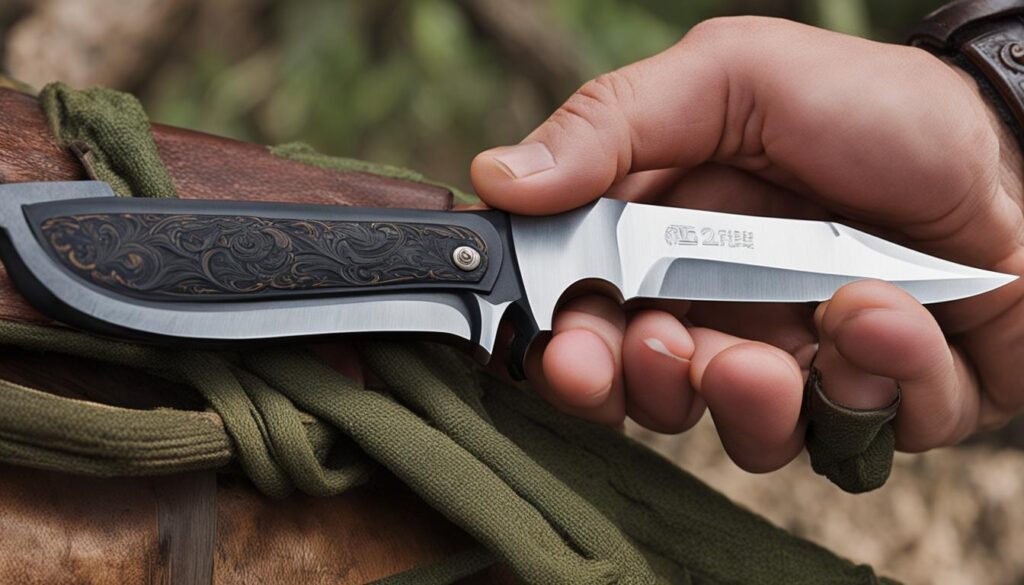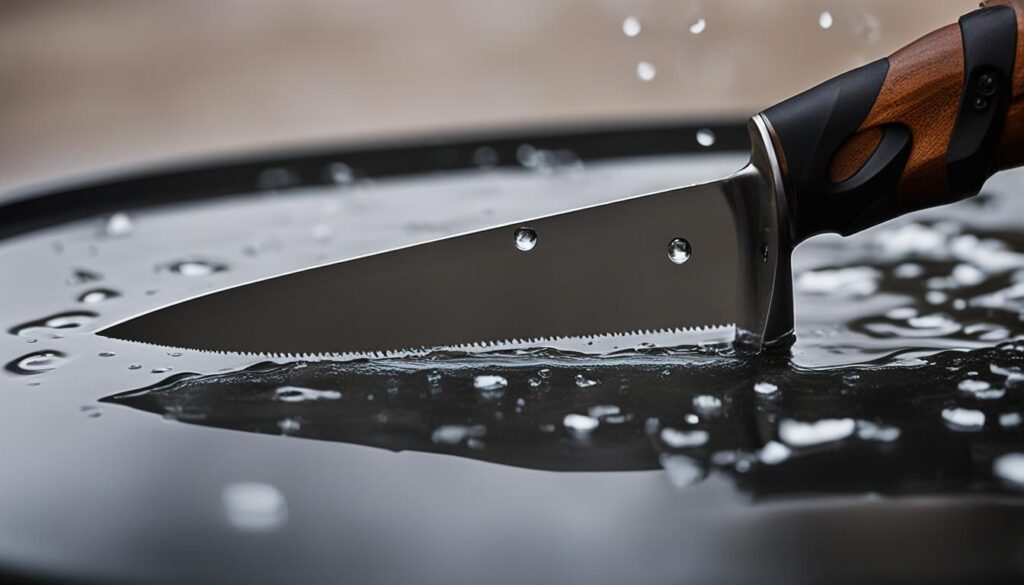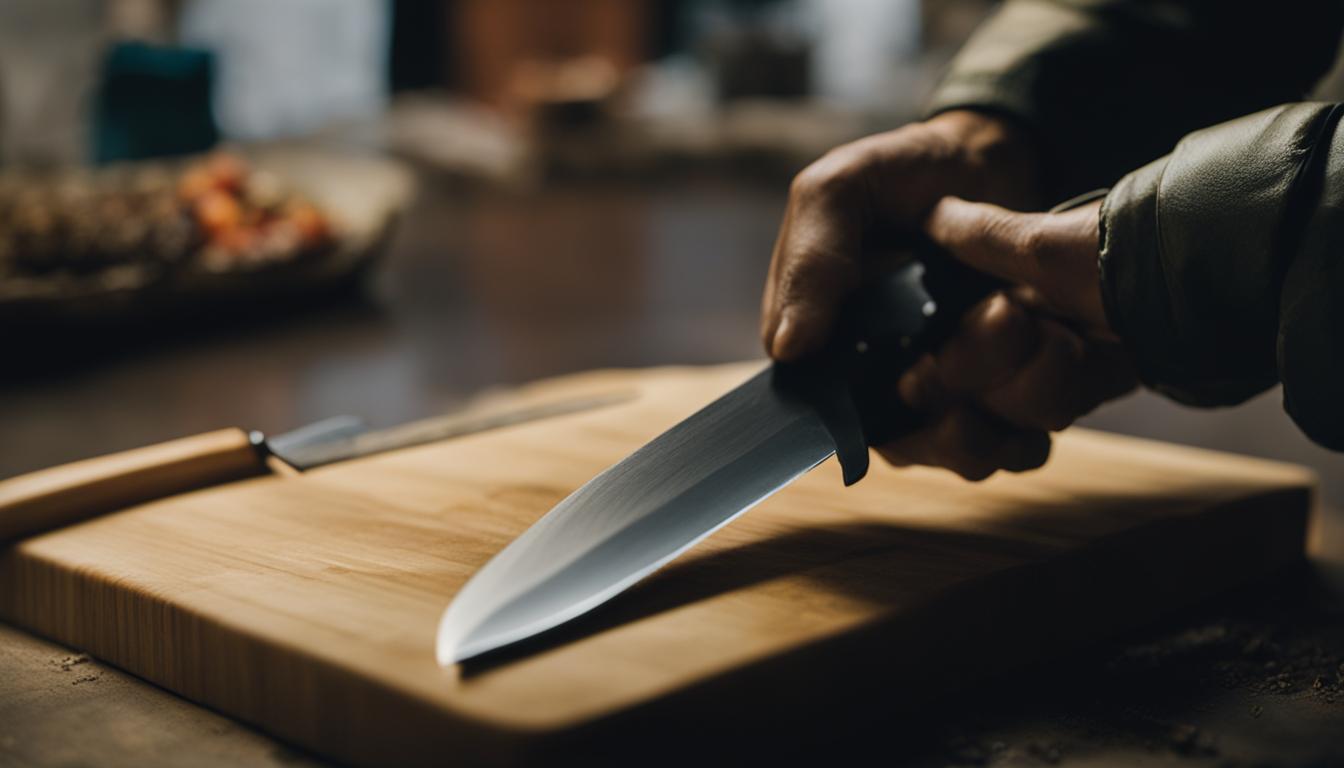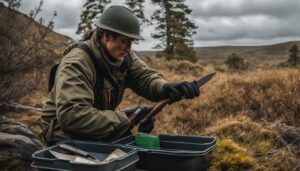When it comes to handling hunting knives, knife safety is paramount. As an avid hunter, I understand the importance of following guidelines to ensure my safety and prevent accidents. In this article, I will share expert advice and recommendations from various sources to help you stay sharp and stay safe while using hunting knives.
Key Takeaways:
- Always maintain a sharp hunting knife for both safety and functionality.
- Learn the proper grip technique to ensure a secure hold and minimize the risk of accidents.
- Cut away from your body and follow proper cutting techniques to avoid injuries.
- Clean your knife thoroughly after each use to prevent corrosion and maintain longevity.
- Invest in a high-quality sheath to protect and store your knife when it’s not in use.
By following these key guidelines, you can enjoy a safe and successful hunting experience. So let’s dive into the details and equip ourselves with the knowledge to handle hunting knives with utmost care and caution.
Keep It Sharp
One of the most important aspects of knife safety is keeping your hunting knife sharp. A dull blade not only hampers the functionality of your knife but can also increase the risk of accidents. Regularly sharpening your hunting knife is essential to maintain its cutting power and ensure safe use in the field.
There are various methods for sharpening hunting knives, but the most commonly used technique is using a sharpening stone. Start by wetting the stone and holding it securely on a flat surface. With the blade at a 20-degree angle, gently slide it across the stone in a sweeping motion, making sure to maintain a consistent angle throughout. Repeat this process on both sides of the blade until you achieve the desired sharpness.
It’s important to note that different blade styles may require specific sharpening techniques. For example, serrated blades should be sharpened individually using a specialized serrated knife sharpener. Additionally, be sure to follow the manufacturer’s instructions and recommendations for sharpening your specific hunting knife.
Regular maintenance of your knife’s blade is also crucial for optimal performance. After sharpening, clean the blade thoroughly to remove any metal shavings or debris. Apply a thin coat of oil to protect against rust and corrosion, and store your knife in a dry and secure location when not in use.
By keeping your hunting knife sharp and properly maintaining its blade, you not only enhance its cutting ability, but you also ensure a safer and more efficient hunting experience.
Table: Comparing Different Knife Sharpening Methods
| Sharpening Method | Pros | Cons |
|---|---|---|
| Sharpening Stone |
|
|
| Electric Knife Sharpener |
|
|
| Sharpening Rod |
|
|
Use the Right Grip
When handling a hunting knife, using the right grip is essential for safety. A proper grip technique ensures a secure hold on the knife, minimizing the risk of accidents. To achieve a solid grip, follow these guidelines:
- Hold the knife with your dominant hand, keeping your fingers away from the blade.
- Wrap your fingers around the handle, maintaining a firm but comfortable grip.
- Position your thumb on the spine of the blade, applying gentle pressure to control the knife’s movement.
The right grip combines strength and steadiness, allowing you to have complete control over the knife while ensuring your safety.
Proper Grip Technique
A proper grip technique involves positioning your hand, fingers, and thumb in a way that maximizes control and minimizes the risk of accidents. By following these steps, you can establish a secure grip on your hunting knife:
- Place your index finger on the back of the knife’s handle, closest to the blade.
- Wrap your remaining fingers around the handle, ensuring a comfortable but firm grip.
- Rest your thumb on the back of the blade, near the handle, exerting gentle pressure to stabilize the knife.
Remember, always maintain a balanced grip and avoid placing your fingers near the blade to prevent accidental cuts or slips.
Table: Types of Knife Grips
| Knife Grip | Description |
|---|---|
| Standard Grip | The most common grip, with the index finger on the spine of the blade and the remaining fingers wrapped around the handle. |
| Reverse Grip | The knife is held with the blade facing downward, with the thumb placed on the handle and the index finger wrapped around the blade. |
| Hammer Grip | The handle is grasped firmly with all fingers wrapped around it, similar to holding a hammer. |
Each grip has its own advantages and is suitable for specific cutting techniques. It’s essential to practice and determine which grip works best for you.

Cut Away from Your Body
When it comes to using a hunting knife, one of the most important safety tips is to always cut away from your body. This simple technique can help minimize the risk of accidents and protect you from potential injuries. By positioning yourself correctly and following proper cutting techniques, you can ensure a safe and efficient cutting experience.
Proper Positioning
Before making any cuts, it’s crucial to position yourself in a way that allows you to cut away from your body. Stand with your feet shoulder-width apart and keep a comfortable distance between your body and the object you’re cutting. This will give you enough space to make clean and controlled cuts without putting yourself in harm’s way.
Obstacle-Free Zone
Another important aspect of cutting away from your body is ensuring that there are no obstacles or obstructions in the path of the blade. Make sure the area around you is clear of any objects that might interfere with your cutting motion. This will help you maintain control of the knife and prevent accidental slips or injuries.
“Always remember to keep your fingers and body parts away from the path of the blade. This simple habit can save you from potential accidents and ensure your safety when using a hunting knife.”
– Knife Safety Expert
By consistently cutting away from your body, you can significantly reduce the risk of accidents while using a hunting knife. This simple yet essential technique, along with proper positioning and maintaining an obstacle-free zone, will help you handle your knife safely and enjoy a successful hunting experience.
Clean Your Knife
Properly cleaning and maintaining your hunting knife is essential for its longevity and your safety. After every use, it is crucial to clean your knife thoroughly to prevent dirt, debris, and potentially corrosive substances from damaging the blade. Follow these steps to ensure your hunting knife remains in optimal condition:
- Gently rinse the blade with warm water to remove any visible dirt or residue. Avoid using harsh chemicals or abrasive materials that could scratch the blade.
- Apply a small amount of mild soap or dishwashing detergent to a soft sponge or cloth.
- Gently scrub the blade using circular motions, paying close attention to any stubborn stains or spots.
- Rinse the blade thoroughly with warm water to remove any soap residue.
- Pat the blade dry with a clean, lint-free cloth or towel. Ensure that it is completely dry before storing to prevent moisture and potential corrosion.
Remember to also clean the handle of your knife if it is made of materials that can be affected by moisture or dirt. Use the same gentle cleaning method as described above, focusing on removing any dirt or grime that may have accumulated.


Cleaning your hunting knife regularly not only keeps it looking its best but also prevents corrosion and ensures that it functions properly. A well-maintained knife will provide years of reliable service and help you stay safe during your hunting expeditions.
Use a Sheath
When it comes to the safety and storage of your hunting knife, a sheath is an essential accessory. A knife sheath is a protective covering that fits snugly over the blade, keeping it secure and preventing any accidental contact. Using a sheath not only helps to preserve the sharpness of your knife but also reduces the risk of injuries when the knife is not in use.
Investing in a high-quality sheath is important to ensure a proper fit for your specific hunting knife. Look for a sheath that is made from durable materials such as leather or nylon, as these materials provide excellent protection against moisture, dust, and other potential damaging elements. Make sure the sheath has a secure closure mechanism, such as a snap or buckle, to keep the knife securely in place.
Using a sheath is a responsible way to store and transport your hunting knife. Whether you’re out in the field or at home, always keep your knife in its sheath when it’s not in use. This will not only keep you safe but also prevent any accidental damage to the blade. Remember, a sheath is a simple yet effective tool that can significantly enhance the safety and longevity of your hunting knife.
The Benefits of Using a Sheath
- Protects the blade from getting dull or damaged
- Prevents accidental injuries when the knife is not in use
- Keeps the knife securely stored and easily accessible
- Reduces the risk of corrosion and rusting
- Allows for safe and convenient transportation
Using a sheath is not just a matter of convenience; it’s a matter of safety. By keeping your hunting knife properly stored in a sheath, you can ensure that it remains sharp, accessible, and most importantly, harmless when not in use. Don’t take any chances – always use a sheath to protect yourself and your knife.
Table: Comparison of Different Sheath Materials
| Sheath Material | Pros | Cons |
|---|---|---|
| Leather | Durable, classic look, molds to the shape of the knife | May require regular conditioning, absorbs moisture if not properly treated |
| Nylon | Lightweight, resistant to moisture and abrasion, easy to clean | Less durable than leather, may not provide as snug a fit for the knife |
| Kydex | Rugged, excellent retention, resistant to wear and tear | Can be noisy, may scratch the blade if not properly lined |
Beware of Safe Surroundings
When it comes to knife safety, it’s not just about how you handle the knife itself. It’s also important to be aware of your surroundings and create a safe environment. By taking certain precautions and avoiding potential hazards, you can greatly reduce the risk of accidents. Here are some knife safety precautions to keep in mind:
Keep Others at a Safe Distance
When handling a hunting knife, make sure to keep others at a safe distance. This is especially important when using the knife to make cuts or perform tasks that require more force. By maintaining a safe distance from others, you can prevent unintentional injuries and ensure the safety of everyone involved.
Avoid Potential Hazards
Before using your hunting knife, take a moment to assess your surroundings for potential hazards. Look for any obstacles or obstructions that could pose a risk and make sure to clear them out of the way. This includes ensuring that there are no loose objects or slippery surfaces that could cause you to lose control of the knife.
Knife safety is not just about how you handle the blade; it’s also about being aware of your surroundings and taking the necessary precautions to avoid accidents.
Pay Attention to the “Blood Bubble” Concept
The “blood bubble” concept refers to the idea of maintaining a safe distance from your own body while using a knife. By keeping your non-dominant arm extended and away from the path of the blade, you can minimize the risk of accidentally cutting yourself. This technique is especially important when performing tasks that require precision and control.
Avoid the Triangle of Death
The “triangle of death” refers to the area between your legs when using a knife. It’s crucial to avoid placing the knife in this area or using it in a way that could lead to injuries. By being mindful of how you position yourself and where you place the knife, you can prevent accidents and ensure your safety.
By following these knife safety precautions and being aware of your surroundings, you can create a safe environment for yourself and others. Remember that knife safety is not just about the knife itself, but also about taking proactive steps to avoid potential hazards and minimize the risk of accidents. Stay vigilant, stay safe!
Conclusion
In conclusion, prioritizing knife safety is crucial when handling hunting knives. By following the guidelines outlined in this article, you can ensure your safety and prevent accidents. Remember to keep your knife sharp for optimal performance and reduced risk of injuries. Regularly sharpening the blade will enable maximum cutting power.
Using the right grip technique is equally important. Maintain a solid and secure grip on the knife, avoiding placing fingers near the blade. This will provide balance, strength, and stability during use.
When cutting, always remember to cut away from your body. Position yourself safely and ensure there are no obstacles in the blade’s path. Employing proper cutting techniques will minimize the risk of accidents and injuries.
Additionally, always clean and store your hunting knife properly. Thoroughly clean it after each use, using warm water and soap, and ensure it is completely dry before storing. This practice prevents dirt, grime, and corrosion.
Investing in a high-quality sheath is a wise decision. A sheath not only protects the blade but also securely stores the knife, reducing the likelihood of accidents and making it easily accessible when needed.
Lastly, create a safe environment by being aware of your surroundings. Keep others at a safe distance and remove any potential hazards. By following these guidelines, you can enjoy a safe and successful hunting experience. Remember, knife safety is a top priority to stay sharp and stay safe!
FAQ
Why is knife safety important when handling hunting knives?
Knife safety is important when handling hunting knives to prevent accidents and ensure the safety of yourself and others.
How often should I sharpen my hunting knife?
It is recommended to regularly sharpen your hunting knife to maintain its functionality and reduce the risk of accidents. The frequency of sharpening will depend on how often you use the knife and the type of tasks it is used for.
How do I properly hold a hunting knife?
Use a proper grip technique when handling a hunting knife to ensure a secure and balanced hold. Avoid placing your fingers near the blade and maintain a grip that combines strength and steadiness.
Why should I cut away from my body when using a hunting knife?
Cutting away from your body minimizes the risk of injury. By positioning yourself in a way that allows you to make cuts safely and avoiding obstacles in the path of the blade, you can prevent accidents.
How do I clean and maintain my hunting knife?
After each use, clean your hunting knife thoroughly with warm water and soap, ensuring it is completely dry before storing it. This prevents dirt or grime from sticking to the metal and reduces the risk of corrosion.
Why should I use a sheath for my hunting knife?
Using a sheath protects the blade, keeps it sharp, and reduces the chances of accidents by securely storing the knife and keeping it out of reach.
How should I create a safe environment when handling a hunting knife?
To create a safe environment, keep others at a safe distance and ensure there are no potential hazards in the area. Pay attention to the “blood bubble” concept and avoid the triangle of death to minimize the risk of accidents.





